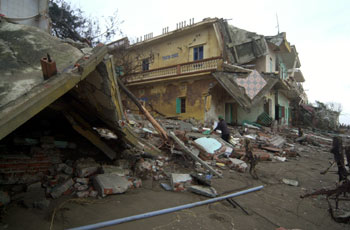 |
James Lewis comments on the narrow focus and lack of innovation and commitment that has prevailed in international programmes when planning comprehensive disaster reduction strategies. |
| The author was co-founder of the "disastrously" short-lived Disaster Research Unit at the University of Bradford, the group that first recognized the importance of vulnerabilities in tackling the problems of disaster occurrence. He was trained and has practiced as an architect in the United Kingdom and is now a consultant, researcher and writer on environmental hazards and human settlements. He has worked with the Commonwealth Secretariat, the United Nations and the European Commission on behalf of Caribbean and South Pacific island states, Algeria and Bangladesh. | |
In a recent article (Tiempo, Issue 62, January 2007), Newswatch editor Sarah Granich usefully reviewed declared statements of international organizations and institutions concerning disaster reduction, gently deploring a certain lassitude of comprehensive adaptation to climate change.
The same could be said, just now, of most national governments, so it is not surprising if the international bodies representative of their participation make no advance. We all know of governments reluctant to be stirred into action not of their own making nor of their own immediate purpose or political interest - this in the contexts of recent extreme events. Why do such great divides persist between specialist findings and policy implementation?
Already sixteen years since the 1991 Intergovernmental Panel on Climate Change report, the first intergovernmental acknowledgment of climate change, much of the response to the 2007 Fourth Assessment report is as if the process had just started.
Without going beyond our own countries, we can see divisions between those actions devoted to reducing emissions on behalf of a more amenable future, and those to do with hazards already imminent or manifest. Take only one United Kingdom national sector to see the carbon-free house of the future on the one hand and, on the other at the same time, permitted built development on flood-prone sites and failures of recent construction against moderately high winds.
When United Kingdom 'disasters' research began in the early 1970s, international programmes on the ground were a poor cousin to development. But for the past twenty years or more, the situation has been the reverse; development budgets have lost out to those allocated in one way or another to disasters. More tragically, 'disasters' became disassociated from 'development', seemingly for better access to direct funding.
Whatever the reason, the regrettable split that ensued between the two camps of 'disasters' and 'development' has been a cause of persistent divisions and a reason why policies for disaster reduction remain too narrowly focused to cope with climate change and all of its associated hazards. Aspects of this disassociation are discussed by the author in Development in Disaster-prone Places: Studies of Vulnerability, published in 1999 (page 127 and following).
In the twenty years since sea-level rise became a concern, there has been adequate time for multi-disciplinary, multi-sectoral and multi-temporal policies to have been formed to take account of one of the greatest disasters to befall the world since Noah built his ark.
 |
Impact of Typhoon Damrey, September 2005, Vietnam
© Luong Quang Huy |
The Davos 2006 recommendations, calling on the international community to adopt an integrated, participatory approach to coping with disasters and risks, are a major step forward. Yet their substance has been part of disaster literature for decades. Implementation has been restricted, constrained and made piecemeal by which camp it belonged to, impeded in the formation of an "integrated participatory approach" for all disasters, all risks and most crucially - all vulnerabilities.
Strategies for vulnerability reduction in developmental contexts would serve the potential victims of all the extremes of a changing climate; social vulnerability to one thing being very often social vulnerability to another. But understanding of the causes of vulnerability has not been helped by globalized and institutionalized conceptions of disasters in distant places. Vulnerability is pervasive in local, community, and domestic contexts, and our insights into its often invidious processes have to be achieved at similar levels of application.
Most disaster policies and programmes remain impeded by overly narrow focus on what happens in and after the event. They focus insufficiently on what has taken place before, and what is continuing to take place before subsequent events - too often brought about, it has to be said, by inappropriate, socially- and environmentally-insensitive, and even corrupt, 'development'. Attempts, in recent years, to integrate a developmental dimension into disaster recovery programmes serve to emphasize this ongoing but pathetic state of affairs.
Integrated national, community and domestic strategies for continued reduction of emissions, which will make environments less severe in the future, have to be accompanied by mutually-supportive and parallel strategies to reduce already apparent vulnerabilities to the hazards of climate change and more: sea-level rise and associated storms, sea-surges, coastal and riverine flooding, high temperatures - and earthquakes as well.
Hazards are not a comfortable topic. Though it is more amenable to implement measures for a more acceptable future than to take action for a fearfully hazardous present, the bullet is there to be bitten. The problem must be recognized for the ultimate achievement of comprehensively advantageous vulnerability reduction.
Further information
James Lewis, 101 High Street, Marshfield, Chippenham, Wiltshire SN14 8LT, United Kingdom. Email: datum@gn.apc.org. Web: www.livingwithflooding.eu.